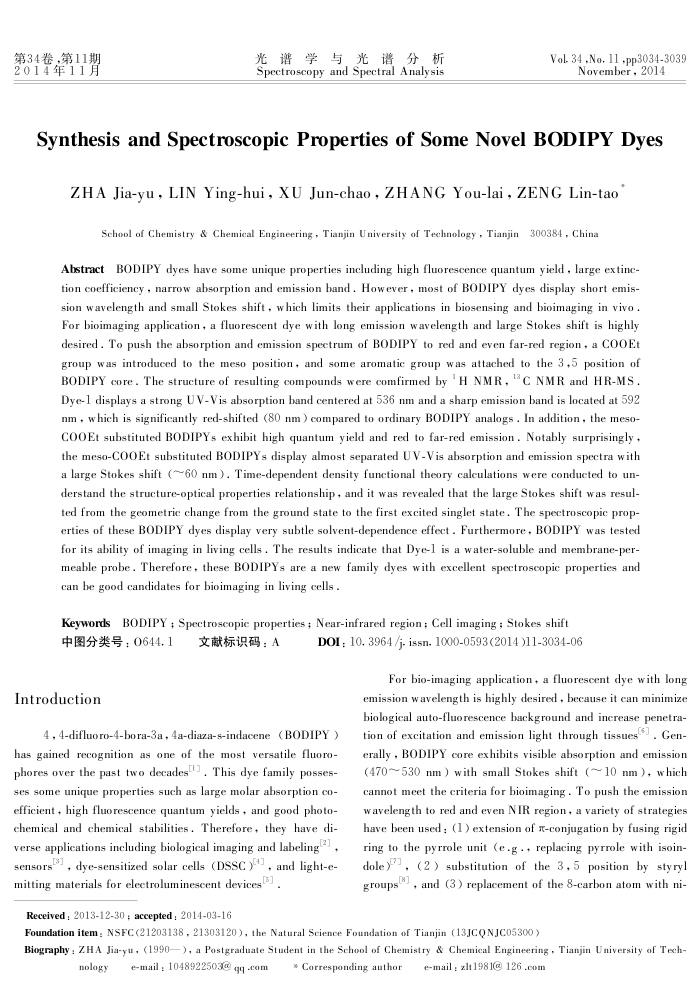新型BODIPY荧光染料的合成及光谱性质研究
内容简介
 第34卷,第11期 2014年11月
第34卷,第11期 2014年11月光谱学与光谱分析 Spectroscopy and Spectral Analysis
Vol. 34 ,No. 11 -pp3034-3039
November, 2014
SynthesisandSpectroscopicPropertiesofSomeNovelBODIPYDyes
ZHA Jia-yu,LIN Ying-hui,XU Jun-chao,ZHANG You-lai, ZENG Lin-tao
School of Chemistry & Chemical Engineering , Tianjin University of Technology , Tianjin 300384 , China
Abstract BODIPY dyes have some unique properties including high fluorescence quantum yield , large extinc tion coefficiency , narrow absorption and emission band. However , most of BODIPY dyes display short emis sion wavelength and small Stokes shift , which limits their applications in biosensing and bioimaging in vivo . For bioimaging application , a fluorescent dye with long emission wavelength and large Stokes shift is highly desired. To push the absorption and emission spectrum of BODIPY to red and even far-red region , a COOEt group was introduced to the meso position, and some aromatic group was attached to the 3,5 position of BODIPY core . The structure of resulting compounds were comfirmed by 'H NMR, I3 C NMR and HR-MS Dye-l displays a strong U V-Vis absorption band centered at 536 nm and a sharp emission band is located at 592 nm , which is significantly red-shifted (8O nm ) compared to ordinary BODIPY analogs . In addition , the meso-COOEt substituted BODIPYs exhibit high quantum yield and red to far-red emission . Notably surprisingly + the meso-COOEt substituted BODIPYs display almost separated UV-Vis absorption and emission spectra with a large Stokes shift (~60 nm ). Time-dependent density functional theory calculations were conducted to un derstand the structure-optical properties relationship, and it was revealed that the large Stokes shift w as resul-ted from the geometric change from the ground state to the first excited singlet state, The spectroscopic prop-erties of these BODIPY dyes display very subtle solvent-dependence effect . Furthermore, BODIPY was tested for its ability of imaging in living cells . The results indicate that Dye-l is a water-soluble and membrane-per meable probe. Therefore, these BODIPYs are a new family dyes with excellent spectroscopic properties and can be good candidates for bioimaging in living cells
Keywords BODIPY ; Spectroscopic properties ; Near-infrared region ; Cell imaging ; Stokes shift
中图分类号:0644.1
Introduction
文献标识码:A
D0I: 10, 3964 /i. issn. 1000-0593(2014 )11-3034-06
For bio-imaging application a fluorescent dye with long emission wavelength is highly desired, because it can minimize biological auto-fluorescence background and increase penetra-
4 , 4-difluoro-4-bora-3a, 4a-diaza-s-indacene (BODIPY ) has gained recognition as one of the most versatile fluoro-phores over the past two decades(u . This dye family posses-ses some unique properties such as large molar absorption co-efficient , high fluorescence quantum yields , and good photo-chemical and chemical stabilities. Therefore , they have di-verse applications including biological imaging and labeling[2] , sensors[3] , dye-sensitized solar cells (DSSC )] , and light-e-
mitting materials for electroluminescent devices Received : 2013-12-30 ; accepted : 2014-03-16
tion of excitation and emission light through tissuesJ . Gen-erally , BODIPY core exhibits visible absorption and emission(470~530 nm) with small Stokes shift (~10 nm), which cannot meet the criteria for bioimaging . To push the emission wavelength to red and even NIR region , a variety of strategies have been used : (1) extension of r-conjugation by fusing rigid ring to the pyrrole unit (e -g - + replacing pyrrole with isoin-dole)71, (2) substitution of the 3, 5 position by styryl groups(*) , and (3) replacement of the 8-carbon atom with ni-
Foundation item: NSFC (21203138 , 21303120 ), the Natural Science Foundation of Tianjin (13JCQNJC05300 )
Biography : ZHA Jia-yu, (1990), a Postgraduate Student in the School of Chemistry & Chemical Engineering , Tianjin University of Tech
nology
e-mail;1048922503@qq-com
Corresponding author
e-mail : zlt1981@126.com